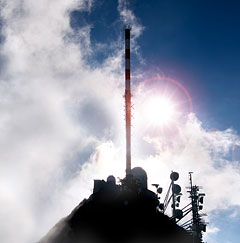Your challenge

Radios and voice communications systems (VCS) can reach their end-of-life at different points in time. Sometimes the radios do so earlier than traditional VCSs.
When replacing obsolete radios, air navigation service providers (ANSP) want to benefit from the advantages provided by VoIP and migrate their infrastructure towards the latest technology in order to ensure a long lasting investment. Enabling interworking of new VoIP radios with traditional VCSs is therefore of highest interest to the ANSPs.
Solutions are required that support a smooth step-by-step migration by interconnecting modern VoIP-based radios with traditional voice communications systems.
Rohde & Schwarz solution
The challenges faced during such step-by-step migration scenarios are well addressed by deploying gateways that have a variety of different interface types, such as the R&S®GW5450 VCS gateway.
Smooth migration
The latest state-of-the-art VCS gateways allow radios with EUROCAE ED-137 compliant VoIP interface to be introduced in the ATC infrastructure while the traditional VCS remains unchanged. It is even possible to have mixed installations of radios with an analog audio interface and radios that already have a VoIP interface. This allows ANSPs to decide which radios at which site are to be replaced with new VoIP radios and when.
Future-ready
Following such an approach, ANSPs can migrate their networks smoothly to IP technology and establish a futureready infrastructure step by step. This also applies to the transport infrastructure itself. Since EUROCAE ED-137 compliant VCS gateways can be positioned either close to the radios at the radio site or at the central office site, they also support the transition from TDM to IP within the transport infrastructure.
Space saving
This step-by-step migration concept not only enables a smooth transition from TDM to IP technology, it also protects the investment in new radios. The newly introduced VoIP radios will not have to be changed during their lifetime. And when the traditional VCS is finally replaced with a EUROCAE ED-137 compliant full-IP VCS, the installed VCS gateways will be removed and can be deployed wherever needed. The existing VoIP radios will then communicate directly with the new full-IP VCS in line with the EUROCAE ED-137 standard.
R&S®VCS-4G with its VCS gateway features all these advantages to the full benefit of the ANSP.
Deployment
An ANSP wants to replace obsolete radios that have an analog audio interface with new radios that have a EUROCAE ED-137 compliant VoIP interface. VCS gateways are to be used for integration into the existing traditional VCS infrastructure. Due to budgetary constraints, replacement will be performed step by step, radio site by radio site. Since the traditional VCS has not yet reached the end of its lifetime, it will be some years before it is replaced by a full-IP VCS.
VCS gateways convert analog and digital audio signals from a traditional VCS to audio signals for modern VoIPbased radios, and vice versa. The gateways therefore provide interfaces of type E & M and E1 for the traditional VCS and of type EUROCAE ED-137 for the VoIP-based radios.
VCS gateways allow leveraging of a future-ready, ED‑137 compliant VoIP radio infrastructure early in the migration process while ANSPs still benefit from maximum reuse of the installed base of traditional VCSs.
Following this implementation strategy, radio receivers and radio transmitters located at different radio sites will be replaced first. While the infrastructure between radio sites and ACC is to be migrated to VoIP (based on an engineered IP network), the VCS gateways are installed in the central office site close to the existing traditional VCS. Depending on the actual configuration, the existing VCS requires only minimal configuration changes. The new radios are fully transparent to the existing system. No hardware or software changes are necessary.
For the controllers operating the air-ground communications, the operational behavior of the traditional VCS remains unchanged. No additional training is necessary for the controllers. Solely the technicians and service personnel have to be trained on the new infrastructure and deployed devices.


